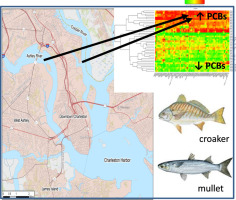Environmental Research ( IF 7.7 ) Pub Date : 2018-08-07 , DOI: 10.1016/j.envres.2018.08.001 Patricia A Fair 1 , Natasha D White 2 , Beth Wolf 3 , Stephen A Arnott 4 , Kurunthachalam Kannan 5 , Rajendiran Karthikraj 5 , John E Vena 3

|
Fish consumption is an important route of exposure to persistent organic pollutants (POPs) in dolphins as well as humans. In order to assess the potential risks associated with these contaminants, 39 whole fish and 37 fillets from fish representing species consumed by dolphins and humans captured from Charleston Harbor and tributaries, South Carolina, USA, were measured for a suite of POPs. Polychlorinated biphenyls (PCBs) were the predominant contaminant with concentrations ranging from 5.02 to 232.20 ng/g in whole fish and 5.42–131.95 ng/g in fillets (weight weight ww) followed by total organochlorine pesticides (OCPs) and polybrominated diphenyl ethers (PBDEs). Total POPs levels varied by location and species with general trends indicating significantly higher levels in fish from the Cooper (93.4 ng/g ww) and Ashley Rivers (56.2 ng/g ww) compared to Charleston Harbor (31.6 ng/g ww). Mullet and spot were found to have significantly higher PCBs, OCPs and total POPs, 2–3 times higher than red drum; mullet were also significantly higher in OCPs compared to seatrout. PCB concentrations in whole fish and fillets exceeded EPA human screening values for cancer risk in all fish sampled. For PCBs in fillets, all samples had values of maximum allowable meals per month that were less than the EPA, FDA guidelines for recommended fish meals per month, suggesting lower (more stringent) allowable fish meals per month. All fish exceeded PBDE wildlife values and all fish except two exceeded the level where 95% of the dolphin population would have tissue levels below the health effect threshold. Considering that POP concentrations in fish potentially consumed by humans exceed human health effect thresholds levels, consumption advisories should be considered as a prudent public health measure.
中文翻译:

美国南卡罗来纳州查尔斯顿港和支流鱼类中的持久性有机污染物:风险评估
鱼类消费是海豚和人类接触持久性有机污染物 (POPs) 的重要途径。为了评估与这些污染物相关的潜在风险,从美国南卡罗来纳州查尔斯顿港和支流捕获的代表海豚和人类食用的物种的 39 条全鱼和 37 条鱼片中的一组持久性有机污染物进行了测量。多氯联苯 (PCB) 是主要污染物,全鱼中的浓度范围为 5.02 至 232.20 ng/g,鱼片中的浓度为 5.42-131.95 ng/g(重量 ww),其次是总有机氯农药 (OCP) 和多溴二苯醚 (PBDE) )。总持久性有机污染物水平因地点和物种而异,总体趋势表明库珀河 (93.4 ng/g ww) 和阿什利河 (56. 2 ng/g ww) 与查尔斯顿港 (31.6 ng/g ww) 相比。发现鲻鱼和斑点鱼的 PCBs、OCPs 和总持久性有机污染物含量明显较高,比红鼓高 2-3 倍;与 seatrout 相比,鲻鱼在 OCP 中的含量也显着更高。整条鱼和鱼片中的 PCB 浓度超过了 EPA 人类对所有采样鱼的癌症风险筛查值。对于鱼片中的多氯联苯,所有样品的每月最大允许鱼粉值都低于 EPA、FDA 每月推荐鱼粉指南,建议每月允许的鱼粉更低(更严格)。所有鱼类都超过了 PBDE 野生动物值,除两条外的所有鱼类都超过了 95% 的海豚种群的组织水平低于健康影响阈值的水平。











































 京公网安备 11010802027423号
京公网安备 11010802027423号